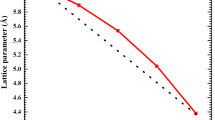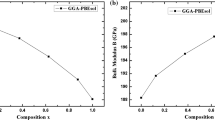Abstract
Bandgap energies of the group III–V quaternary alloy semiconductor, cubic AlxIn1−xNySb1−y, were calculated by means of the dielectric method. The calculation results show that the bandgap energy range covered in the direct transition regime of this alloy system was extended to a significantly lower energy value as compared to the AlxGa1−xNyAs1−y case in our previous work, while no noticeable difference was found in the upper limit energy values between the two quaternary alloy systems. The extension to the lower energy side was attributed to the large bowing in the bandgap energy due to the larger difference in atomic radius between N and Sb than that between N and As. Lattice matching of AlxIn1−xNySb1−y to Si and GaAs yielded only negative bandgap energies. On the other hand, the alloy lattice-matched to GaN possessed a direct transition band structure with bandgap energies ranging between ~ 2.02 and ~ 3.81 eV.
Graphical abstract




Similar content being viewed by others
Data availability
The datasets generated and analyzed during the reported study are available from the corresponding author on a reasonable request.
References
S. Adachi, Properties of Semiconductor Alloys: Group-IV, III–V, and II–VI Semiconductors (Wiley, West Sussex, 2009)
H. Naoi, T. Matsumoto, MRS Adv. 1, 175 (2016)
J.A. Van Vechten, Phys. Rev. 182, 891 (1969)
J.A. Van Vechten, Phys. Rev. 187, 1007 (1969)
J.A. Van Vechten, T.K. Bergstresser, Phys. Rev. B 1, 3351 (1970)
Y. Ueta, Doctoral Dissertation (The University of Tokushima, March 1995)
M. Weyers, M. Sato, Appl. Phys. Lett. 62, 1396 (1993)
H. Naoi, Y. Naoi, S. Sakai, Solid State Electron. 41, 319 (1997)
T. Ashley, T.M. Burke, G.J. Pryce, A.R. Adams, A. Andreev, B.N. Murdin, E.P. O’Reilly, C.R. Pidgeon, Solid State Electron. 47, 387 (2003)
S. Sakai, Y. Ueta, Y. Terauchi, Jpn. J. Appl. Phys. 32, 4413 (1993)
S. Adachi, J. Appl. Phys. 61, 4869 (1987)
I. Vurgaftman, J.R. Meyer, J. Appl. Phys. 94, 3675 (2003)
Y.P. Varshni, Physica (Amsterdam) 34, 149 (1967)
J. Schörmann, D.J. As, K. Lischka, P. Schley, R. Goldhahn, S.F. Li, W. Löffler, M. Hetterich, H. Kalt, Appl. Phys. Lett. 89, 261903 (2006)
A. Gueddim, R. Zerdoum, N. Bouarissa, J. Phys. Chem. Solids 67, 1618 (2006)
I. Vurgaftman, J.R. Meyer, L.R. Ram-Mohan, J. Appl. Phys. 89, 5815 (2001)
Acknowledgments
The authors would like to thank M. Onozuka and M. Ikemoto for their past contributions leading to this work. The authors would also like to thank D. Marsh for checking the English in this paper.
Author information
Authors and Affiliations
Corresponding author
Ethics declarations
Conflict of interest
On behalf of all authors, the corresponding author states that there is no conflict of interest.
Rights and permissions
About this article
Cite this article
Naoi, H., Iwai, S. & Ohara, R. Bandgap energies of cubic AlxIn1−xNySb1−y calculated by means of the dielectric method. MRS Advances 7, 528–532 (2022). https://doi.org/10.1557/s43580-022-00295-2
Received:
Accepted:
Published:
Issue Date:
DOI: https://doi.org/10.1557/s43580-022-00295-2




